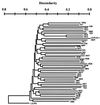Characterization of chloramphenicol and florfenicol resistance in Escherichia coli associated with bovine diarrhea
- PMID: 11101601
- PMCID: PMC87642
- DOI: 10.1128/JCM.38.12.4593-4598.2000
Characterization of chloramphenicol and florfenicol resistance in Escherichia coli associated with bovine diarrhea
Abstract
Florfenicol, a veterinary fluorinated analog of thiamphenicol, is approved for treatment of bovine respiratory pathogens in the United States. However, florfenicol resistance has recently emerged among veterinary Escherichia coli isolates incriminated in bovine diarrhea. The flo gene, which confers resistance to florfenicol and chloramphenicol, has previously been identified in Photobacterium piscicida and Salmonella enterica serovar Typhimurium DT104. The flo gene product is closely related to the CmlA protein identified in Pseudomonas aeruginosa. The cmlA gene confers nonenzymatic chloramphenicol resistance via an efflux mechanism. Forty-eight E. coli isolates recovered from calves with diarrhea, including 41 that were both chloramphenicol and florfenicol resistant, were assayed for the presence of both flo and cmlA genes. Forty-two of the 44 isolates for which florfenicol MICs were > or =16 microg/ml were positive via PCR for the flo gene. All E. coli isolates for which florfenicol MICs were < or =8 microg/ml were negative for the flo gene (n = 4) Twelve E. coli isolates were positive for cmlA, and chloramphenicol MICs for all 12 were > or =32 microg/ml. Additionally, eight isolates were positive for both flo and cmlA, and both florfenicol and chloramphenicol MICs for these isolates were > or =64 microg/ml. DNA sequence analysis of the E. coli flo gene demonstrated 98% identity to the published GenBank sequences of both serovar Typhimurium flo(St) and P. piscicida pp-flo. The flo gene was identified on high-molecular-weight plasmids of approximately 225 kb among the majority of florfenicol-resistant E. coli isolates. However, not all of the florfenicol-resistant E. coli isolates tested contained the large flo-positive plasmids. This suggests that several of the E. coli isolates may possess a chromosomal flo gene. The E. coli flo gene specifies nonenzymatic cross-resistance to both florfenicol and chloramphenicol, and its presence among bovine E. coli isolates of diverse genetic backgrounds indicates a distribution much wider than previously thought.
Figures



Similar articles
-
Relationship between phenotypic and genotypic florfenicol resistance in Escherichia coli.Antimicrob Agents Chemother. 2004 Oct;48(10):4047-9. doi: 10.1128/AAC.48.10.4047-4049.2004. Antimicrob Agents Chemother. 2004. PMID: 15388477 Free PMC article.
-
Evolution of chloramphenicol resistance, with emergence of cross-resistance to florfenicol, in bovine Salmonella Typhimurium strains implicates definitive phage type (DT) 104.J Med Microbiol. 2000 Jan;49(1):103-110. doi: 10.1099/0022-1317-49-1-103. J Med Microbiol. 2000. PMID: 10628832
-
Detection of multidrug-resistant Salmonella enterica serotype typhimurium DT104 based on a gene which confers cross-resistance to florfenicol and chloramphenicol.J Clin Microbiol. 1999 May;37(5):1348-51. doi: 10.1128/JCM.37.5.1348-1351.1999. J Clin Microbiol. 1999. PMID: 10203484 Free PMC article.
-
Molecular basis of bacterial resistance to chloramphenicol and florfenicol.FEMS Microbiol Rev. 2004 Nov;28(5):519-42. doi: 10.1016/j.femsre.2004.04.001. FEMS Microbiol Rev. 2004. PMID: 15539072 Review.
-
A review on the antibiotic florfenicol: Occurrence, environmental fate, effects, and health risks.Environ Res. 2024 Mar 1;244:117934. doi: 10.1016/j.envres.2023.117934. Epub 2023 Dec 16. Environ Res. 2024. PMID: 38109957 Review.
Cited by
-
Characterization of multidrug-resistant Escherichia coli isolates associated with nosocomial infections in dogs.J Clin Microbiol. 2002 Oct;40(10):3586-95. doi: 10.1128/JCM.40.10.3586-3595.2002. J Clin Microbiol. 2002. PMID: 12354850 Free PMC article.
-
Polyamino-Isoprenyl Derivatives as Antibiotic Adjuvants and Motility Inhibitors for Bordetella bronchiseptica Porcine Pulmonary Infection Treatment.Front Microbiol. 2019 Aug 13;10:1771. doi: 10.3389/fmicb.2019.01771. eCollection 2019. Front Microbiol. 2019. PMID: 31456758 Free PMC article.
-
Effects of tylosin use on erythromycin resistance in enterococci isolated from swine.Appl Environ Microbiol. 2004 Jul;70(7):4205-10. doi: 10.1128/AEM.70.7.4205-4210.2004. Appl Environ Microbiol. 2004. PMID: 15240302 Free PMC article.
-
A One Health Comparative Assessment of Antimicrobial Resistance in Generic and Extended-Spectrum Cephalosporin-Resistant Escherichia coli from Beef Production, Sewage and Clinical Settings.Microorganisms. 2020 Jun 11;8(6):885. doi: 10.3390/microorganisms8060885. Microorganisms. 2020. PMID: 32545206 Free PMC article.
-
Heterogeneity among virulence and antimicrobial resistance gene profiles of extraintestinal Escherichia coli isolates of animal and human origin.J Clin Microbiol. 2004 Dec;42(12):5444-52. doi: 10.1128/JCM.42.12.5444-5452.2004. J Clin Microbiol. 2004. PMID: 15583263 Free PMC article.
References
-
- Adesiyun A A, Kaminjolo J S. Susceptibility to antibiotics of Escherichia coli strains isolated from diarrhoeic and non-diarrhoeic livestock in Trinidad. Rev Elev Med Vet Pays Trop. 1992;45:260–262. - PubMed
-
- Arcangioli M A, Leroy-Sétrin S, Martel J L, Chaslus-Dancla E. A new chloramphenicol and florfenicol resistance gene flanked by two integron structures in Salmonella typhimurium DT104. FEMS Microbiol Lett. 1999;174:327–332. - PubMed
-
- Arcangioli M A, Leroy-Sétrin S, Martel J L, Chaslus-Dancla E. Evolution of chloramphenicol resistance, with emergence of cross-resistance to florfenicol, in bovine Salmonella Typhimurium strains implicates definitive phage type (DT) 104. J Med Microbiol. 2000;49:103–110. - PubMed
Publication types
MeSH terms
Substances
Grants and funding
LinkOut - more resources
Full Text Sources
Other Literature Sources
Medical
Miscellaneous

